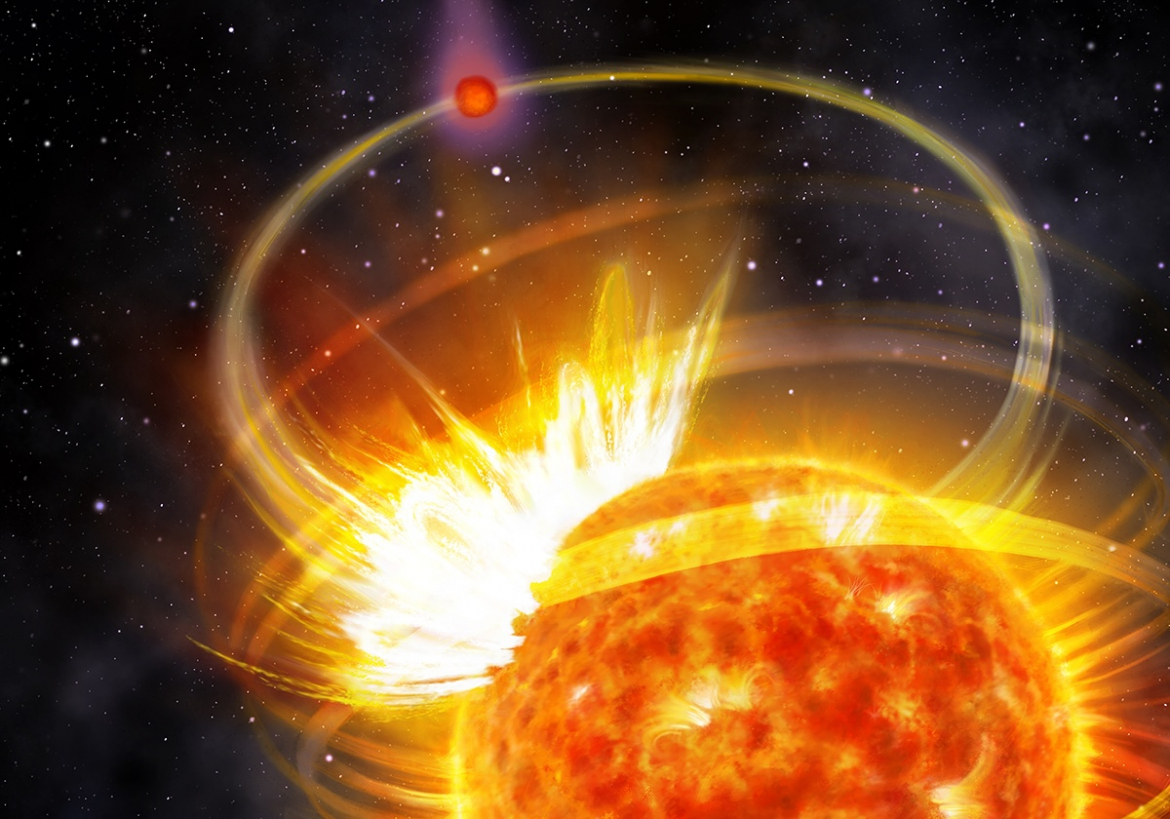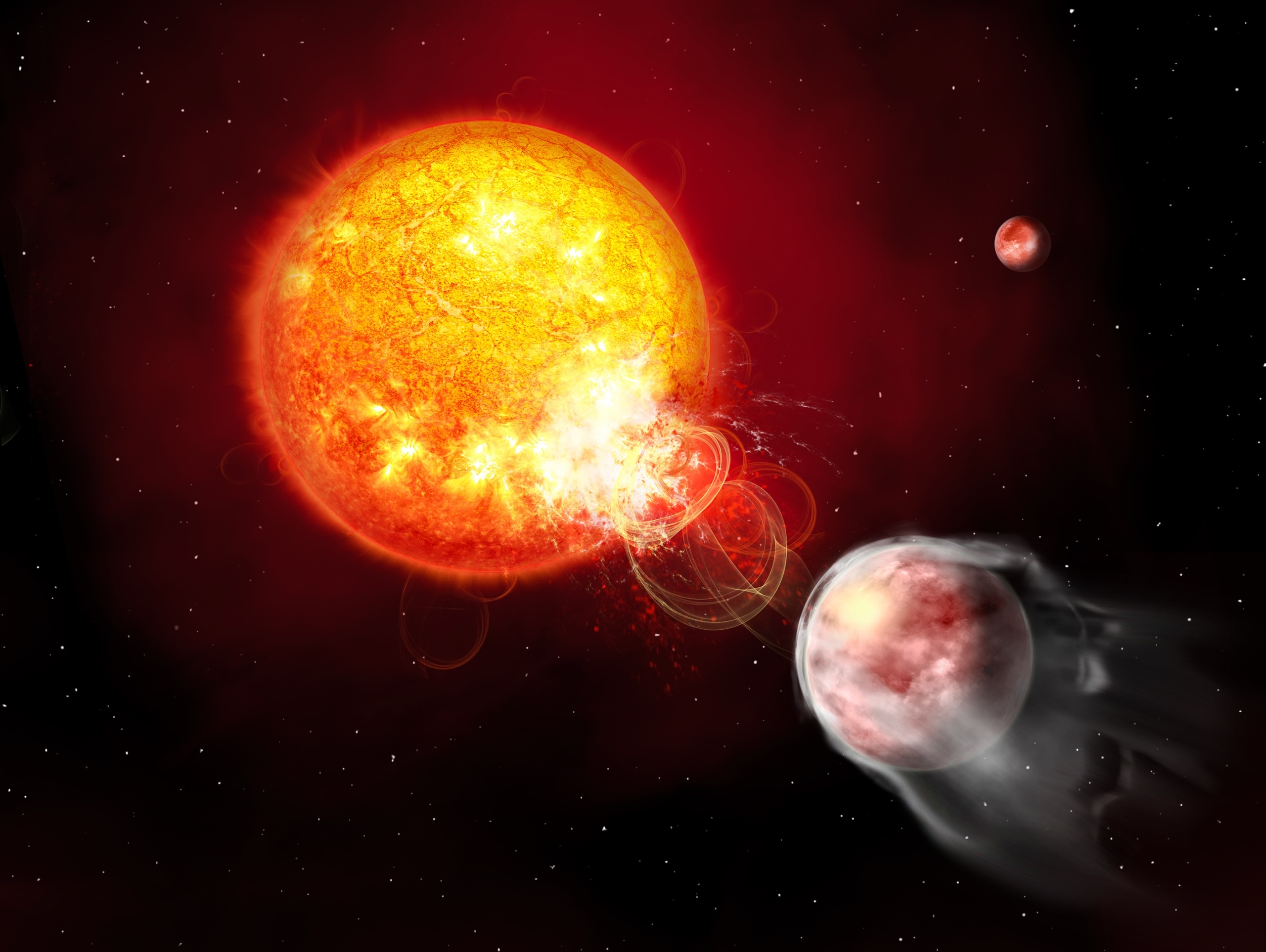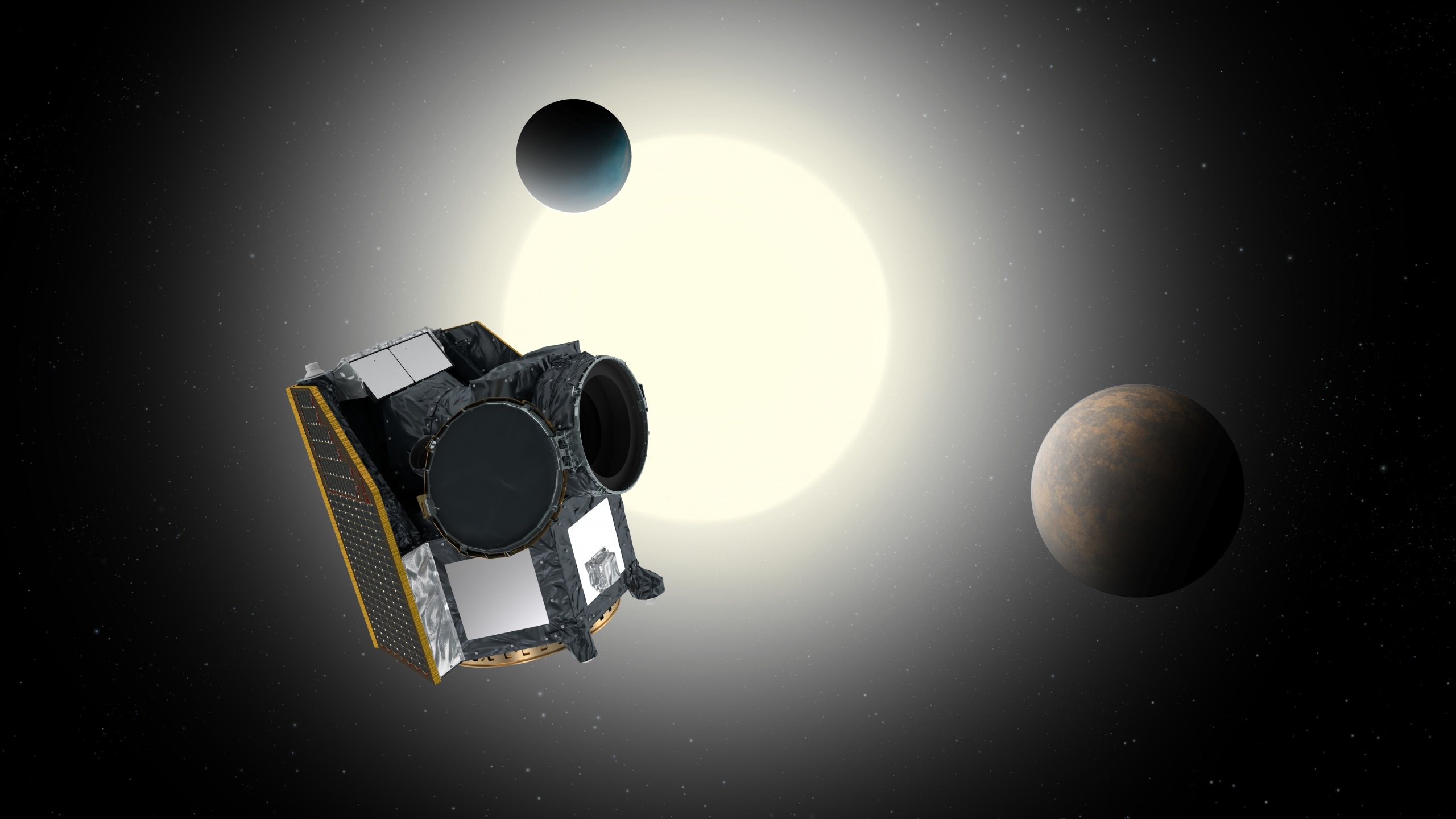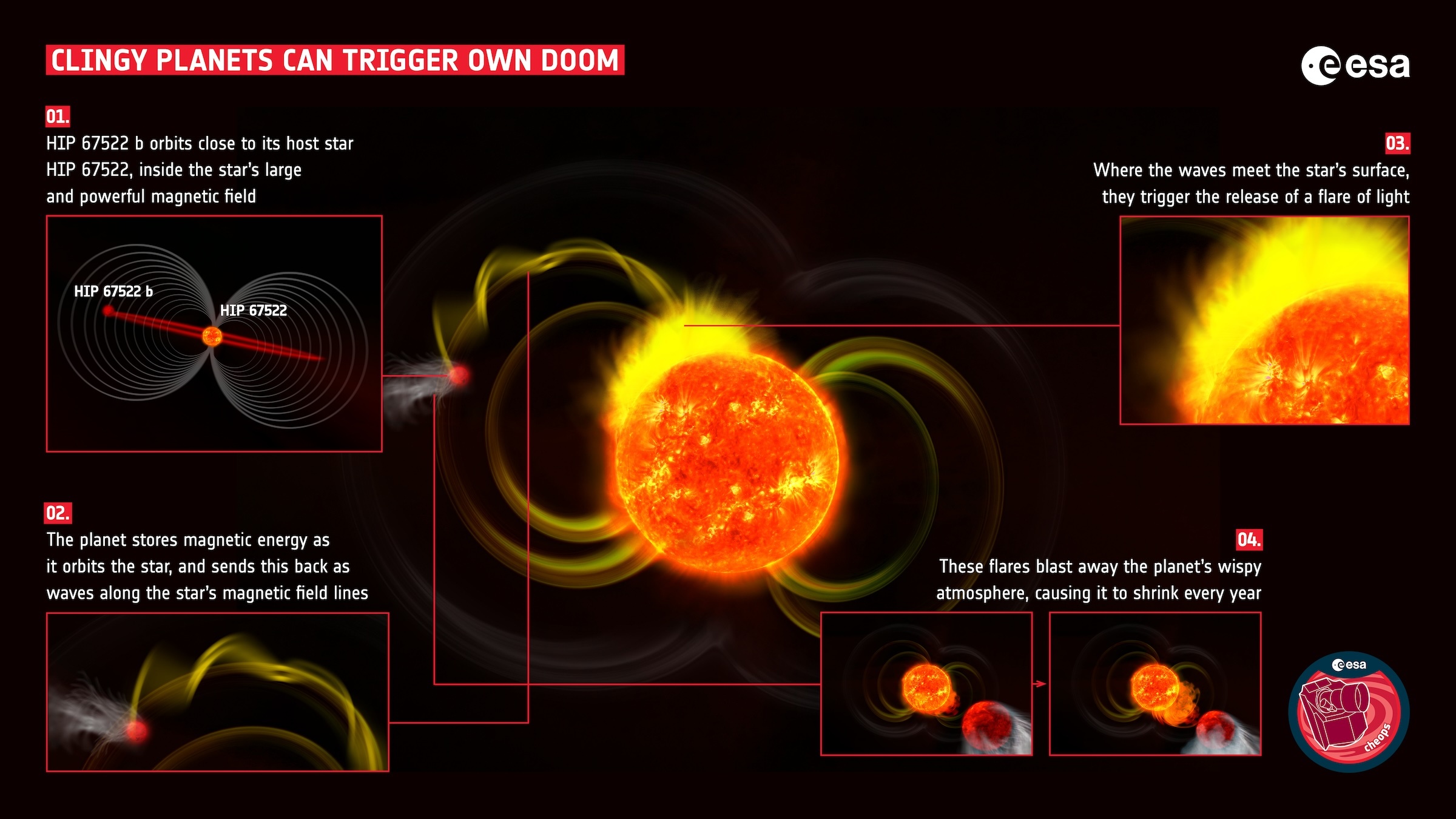22.07.2025
CHEOPS discovers exoplanet triggering explosive flares on host star

Using the European Space Agency’s Characterizing Exoplanets Satellite (CHEOPS) telescope, a team of astronomers has discovered an exoplanet that may be triggering its host star to release massive flares of radiation. These flares are similar to the coronal mass ejection our Sun produces, and the harsh radiation emitted from the flares is slowly blowing away the exoplanet’s atmosphere.
While scientists have predicted this phenomenon for decades, this is the first evidence of an exoplanet triggering flares. Interestingly, the flares observed by CHEOPS are 100 times more energetic than scientists predicted they would be.
The star, named HIP 67522, and its two exoplanets have been studied by other space telescopes prior to CHEOPS, with the James Webb Space Telescope and the Transiting Exoplanet Survey Satellite (TESS) having previously observed the system. From these observations, scientists have learned that HIP 67522 is slightly larger and cooler than our Sun, but is significantly younger. Our Sun is approximately 4.5 billion years old, while HIP 67522 is only 17 million years old.
The exoplanet igniting flares on HIP 67522 is named HIP 67522 b, and is the closer of the star’s two exoplanets. HIP 67522 orbits HIP 67522 extremely fast, taking just seven days to complete one orbit around the star.

Due to HIP 67522’s size and young age, astronomers expected the star to be highly active and energetically churn and spin with a powerful magnetic field. This magnetic field can lead to bursts of flares when twisted magnetic field lines are released by the star, emitting a range of radiation, including radio waves, visible light, gamma rays, and more. Such a phenomenon has been extensively observed and studied on our Sun, which, while similar in size to HIP 67522, features a smaller and less energetic magnetic field.
As mentioned, astronomers have long theorized that exoplanets can induce flares from their host stars if they orbit close enough to disturb their stars’ magnetic fields. After many questions, papers, and studies into the feasibility of this theory, a team of scientists led by Ekaterina Ilin at the Netherlands Institute for Radio Astronomy (ASTRON) utilized modern-day telescopes to learn more.
“We hadn’t seen any systems like HIP 67522 before; when the planet was found, it was the youngest planet known to be orbiting its host star in less than 10 days,” Ilin said.
Ilin et al. began by using NASA’s TESS telescope to perform a large “sweep” of stars that were known to be active and featured exoplanets orbiting close enough to trigger flares. HIP 67522 immediately stood out to the team when they received the results from TESS, and they decided to investigate the HIP 67522 system further using CHEOPS, which is specifically designed to characterize and investigate exoplanets.

“We quickly requested observing time with CHEOPS, which can target individual stars on demand, ultra-precisely. With CHEOPS, we saw more flares, taking the total count to 15, almost all coming in our direction as the planet transited in front of the star as seen from Earth,” said Ilin.
CHEOPS’s observation of flares being emitted toward Earth as HIP 67522 b was transiting was great news, as it meant the planet was very likely inducing flares on HIP 67522.
While seeing a star flare is nothing new for astronomers, the radiation emitted by the star normally is emitted along its own magnetic field lines with no interaction from surrounding planets. However, given HIP 67522 b’s extreme proximity to HIP 67522, the planet’s own magnetic field may be interfering with the star’s.
As the planet orbits HIP 67522, it collects energy and directs it back toward HIP 67522 along the star’s magnetic field lines as a massive wave. When this wave of energy eventually makes its way to the star’s surface after traveling along a magnetic field line, a massive flare is triggered — similar to a rope being whipped.

“The planet seems to be triggering particularly energetic flares. The waves it sends along the star’s magnetic field lines kick off flares at specific moments. But the energy of the flares is much higher than the energy of the waves. We think that the waves are setting off explosions that are waiting to happen,” Ilin explained.
This is the first time such an event has been directly observed by a telescope, and the first time a planet has ever been seen to be influencing its host star. Until now, it was widely accepted that stars dominate their planets and act independently.
What’s more, every time HIP 67522 b triggers a flare on HIP 67522, the flare is emitted back directly toward HIP 67522 b. Due to this, the exoplanet is exposed to six times more radiation than it would if it orbited at a “normal” distance.
Unsurprisingly, experiencing six times the normal amount of radiation has some negative effects on HIP 67522 b. The planet, which is similar in size to Jupiter, hosts a massive atmosphere but is as dense as cotton candy. As these flares repeatedly bombard HIP 67522 b, its atmosphere is slowly eroded, leading to the planet losing mass at a much faster rate than is normally expected for a planet of its size. In fact, if it continues to trigger flares from HIP 67522, it may shrink from a Jupiter-sized exoplanet to a smaller Neptune-sized exoplanet within the next 100 million years.
While HIP 67522 is the first observation of this phenomenon, Ilin et al. have already identified other, similar systems to HIP 67522 that may be experiencing the same events. The team plans to utilize dedicated exoplanet telescopes, such as CHEOPS and TESS, to investigate these systems and gain a deeper understanding of the physics and nature of the phenomenon. “I have a million questions because this is a completely new phenomenon, so the details are still not clear,” said Ilin.
“There are two things that I think are most important to do now. The first is to follow up in different wavelengths to find out what kind of energy is being released in these flares — for example, ultraviolet and X-rays are especially bad news for the exoplanet. The second is to find and study other similar star-planet systems; by moving from a single case to a group of 10–100 systems, theoretical astronomers will have something to work with,” Ilin explained.
Members of the CHEOPS team never expected the telescope to be used to investigate such a phenomenon.The telescope’s mission is to characterize exoplanets by determining their size, which, in turn, enables scientists to determine their mass, composition, density, and other properties.
“Cheops was designed to characterise the sizes and atmospheres of exoplanets, not to look for flares. It’s really beautiful to see the mission contributing to this and other results that go so far beyond what it was envisioned to do,” said CHEOPS project scientist Maximillian Günther of the European Space Agency (ESA).
Following its launch in late 2026, ESA’s upcoming Planetary Transits and Oscillations of stars (PLATO) telescope is expected to observe stars like HIP 67522 and observe flares in even greater detail. PLATO will be able to capture flares that are significantly smaller than the flares observed by CHEOPS, which will allow Ilin et al. to confirm their results.
Quelle: NSF
